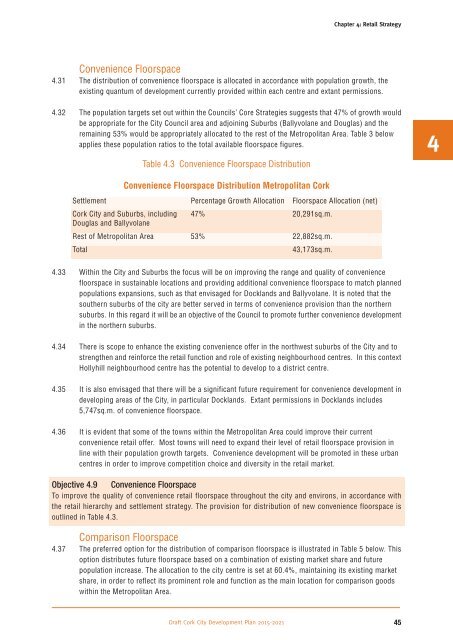Volume 1 Written Statement
Volume 1 Written Statement
Volume 1 Written Statement
Create successful ePaper yourself
Turn your PDF publications into a flip-book with our unique Google optimized e-Paper software.
Chapter 4: Retail Strategy<br />
x<br />
Convenience Floorspace<br />
4.31 The distribution of convenience floorspace is allocated in accordance with population growth, the<br />
existing quantum of development currently provided within each centre and extant permissions.<br />
4.32 The population targets set out within the Councils’ Core Strategies suggests that 47% of growth would<br />
be appropriate for the City Council area and adjoining Suburbs (Ballyvolane and Douglas) and the<br />
remaining 53% would be appropriately allocated to the rest of the Metropolitan Area. Table 3 below<br />
applies these population ratios to the total available floorspace figures.<br />
Table 4.3 Convenience Floorspace Distribution<br />
4<br />
Convenience Floorspace Distribution Metropolitan Cork<br />
Settlement Percentage Growth Allocation Floorspace Allocation (net)<br />
Cork City and Suburbs, including 47% 20,291sq.m.<br />
Douglas and Ballyvolane<br />
Rest of Metropolitan Area 53% 22,882sq.m.<br />
Total<br />
43,173sq.m.<br />
4.33 Within the City and Suburbs the focus will be on improving the range and quality of convenience<br />
floorspace in sustainable locations and providing additional convenience floorspace to match planned<br />
populations expansions, such as that envisaged for Docklands and Ballyvolane. It is noted that the<br />
southern suburbs of the city are better served in terms of convenience provision than the northern<br />
suburbs. In this regard it will be an objective of the Council to promote further convenience development<br />
in the northern suburbs.<br />
4.34 There is scope to enhance the existing convenience offer in the northwest suburbs of the City and to<br />
strengthen and reinforce the retail function and role of existing neighbourhood centres. In this context<br />
Hollyhill neighbourhood centre has the potential to develop to a district centre.<br />
4.35 It is also envisaged that there will be a significant future requirement for convenience development in<br />
developing areas of the City, in particular Docklands. Extant permissions in Docklands includes<br />
5,747sq.m. of convenience floorspace.<br />
4.36 It is evident that some of the towns within the Metropolitan Area could improve their current<br />
convenience retail offer. Most towns will need to expand their level of retail floorspace provision in<br />
line with their population growth targets. Convenience development will be promoted in these urban<br />
centres in order to improve competition choice and diversity in the retail market.<br />
Objective 4.9 Convenience Floorspace<br />
To improve the quality of convenience retail floorspace throughout the city and environs, in accordance with<br />
the retail hierarchy and settlement strategy. The provision for distribution of new convenience floorspace is<br />
outlined in Table 4.3.<br />
Comparison Floorspace<br />
4.37 The preferred option for the distribution of comparison floorspace is illustrated in Table 5 below. This<br />
option distributes future floorspace based on a combination of existing market share and future<br />
population increase. The allocation to the city centre is set at 60.4%, maintaining its existing market<br />
share, in order to reflect its prominent role and function as the main location for comparison goods<br />
within the Metropolitan Area.<br />
Draft Cork City Development Plan 2015-2021<br />
45


